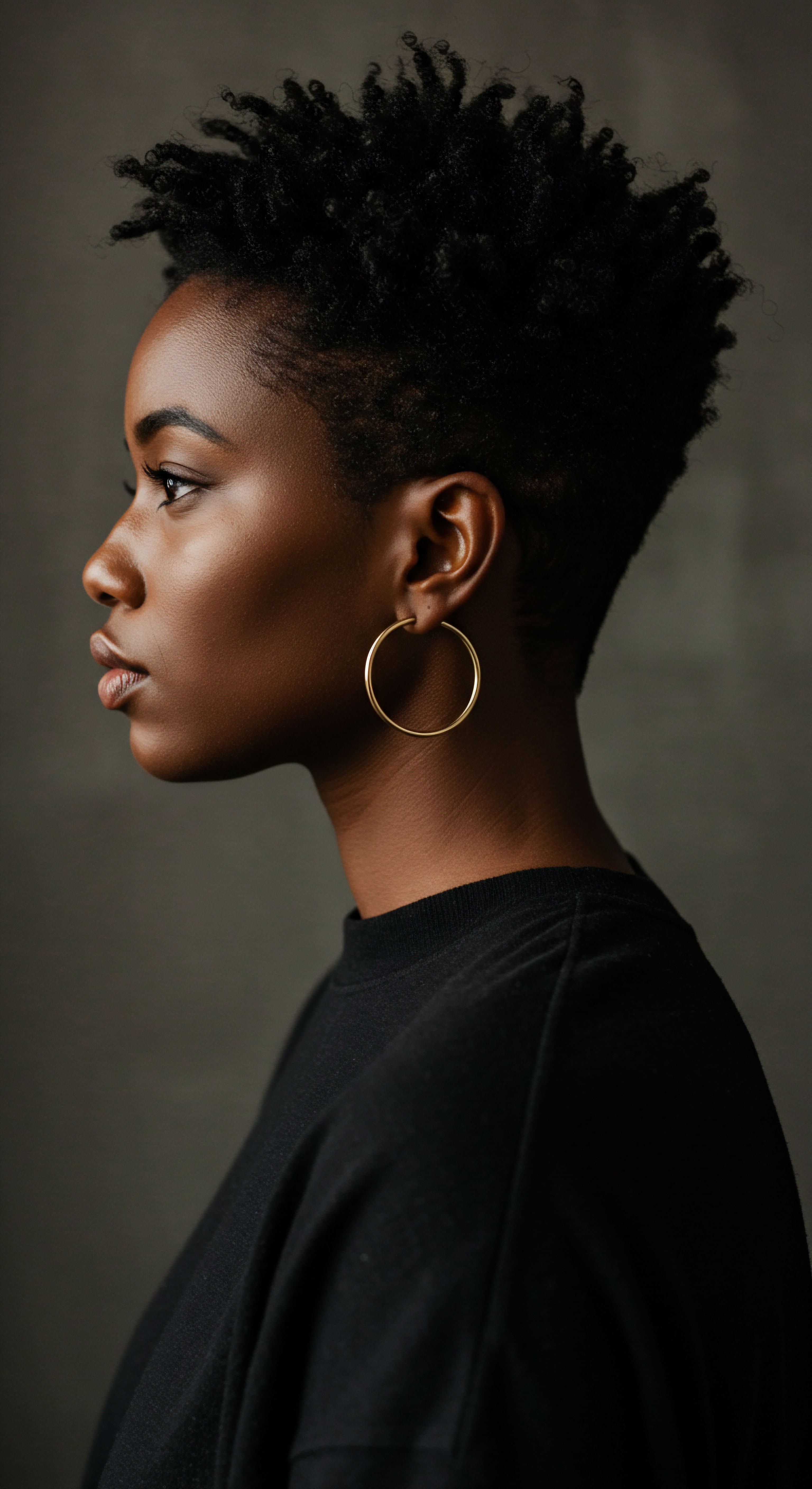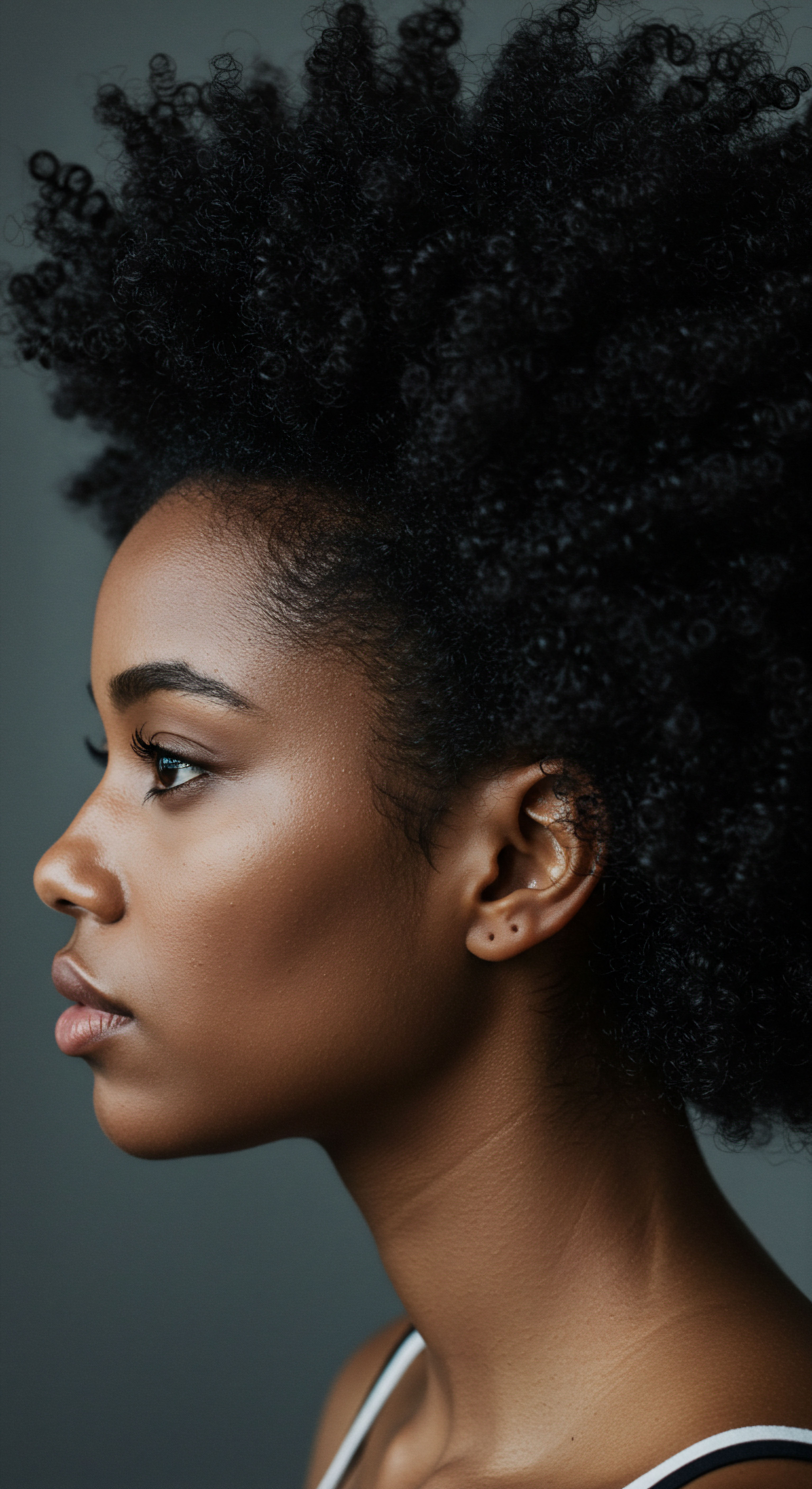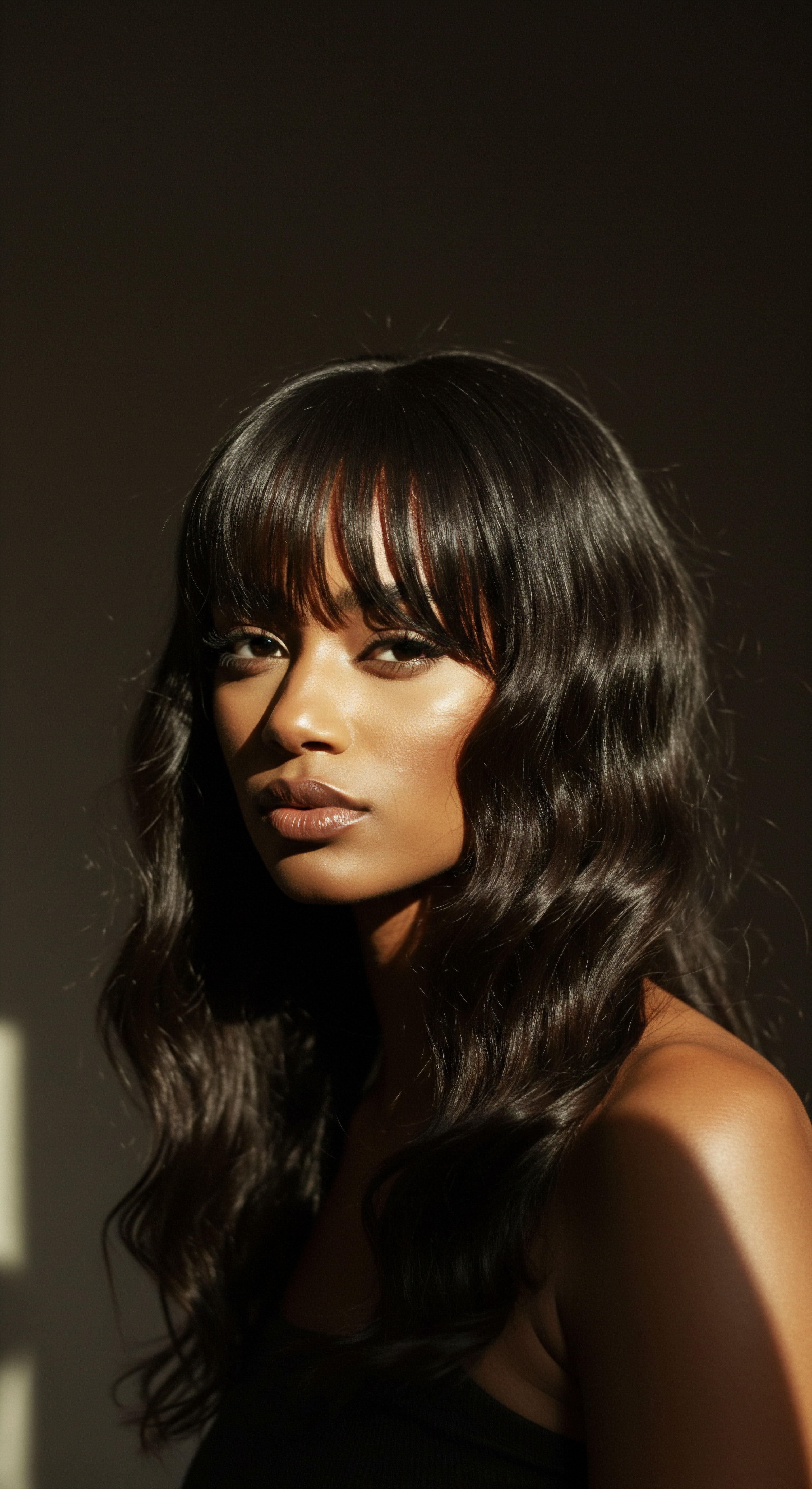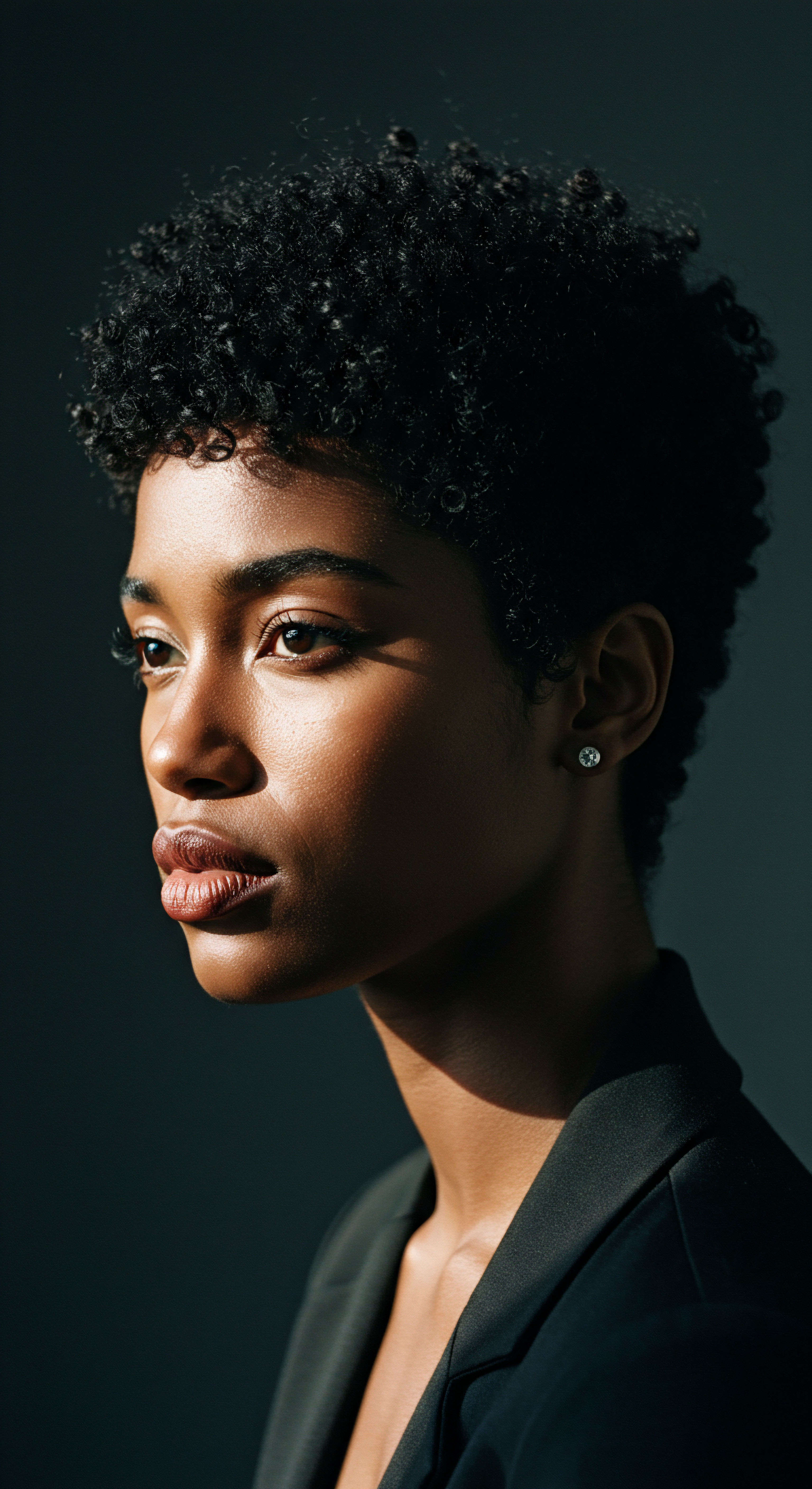
Roots
In the quiet hours, as the world stills and shadows lengthen, a subtle yet profound act of preservation often takes place, one that echoes through the corridors of time. We speak of the gentle art of safeguarding hair, particularly elaborate styles, during the vulnerable moments of rest. This isn’t merely a contemporary concern for those with textured hair, seeking to preserve their intricate braids or coils overnight.
This quiet wisdom, this understanding of hair’s delicate nature and its need for protection, has roots stretching back to ancient civilizations, where hair was not just a personal adornment but a profound marker of identity, status, and spiritual connection. The way ancient peoples tended their hair, even in slumber, offers a window into their respect for self and their connection to the world around them.

Hair as a Living Crown
Across diverse cultures, hair has held a place of reverence, seen as an extension of the individual’s spirit and a visible sign of their standing within society. In ancient Egypt, for example, hair and wigs were not only symbols of power and status but also carried religious beliefs. The meticulous care given to these coiffures, both in life and in death, underscores their deep significance.
Similarly, many African cultures viewed hair as a conduit for spiritual energy and a canvas for expressing tribal affiliation, age, and marital status. The careful management of hair, therefore, extended beyond mere aesthetics; it was a daily reaffirmation of one’s place in the cosmic order.

The Hair Follicle’s Ancient Vulnerability
Despite its apparent resilience, hair, particularly textured hair, possesses inherent vulnerabilities. Its structure, often characterized by twists and turns, creates points of weakness where strands can catch, tangle, and break. Ancient peoples, perhaps through observation rather than microscopic analysis, understood this delicate balance. They recognized that the friction of movement against rough surfaces, the pull of gravity during sleep, and the loss of moisture could compromise the integrity of their carefully constructed styles.
This intuitive understanding drove the development of practices aimed at minimizing such damage. The very nature of the hair strand, with its outer cuticle layers, suggests a need for gentle handling to prevent lifting and subsequent damage. The desire to maintain elaborate coiffures, often requiring hours of work, also provided a strong impetus for nighttime protection, ensuring that the artistry of the day could endure.

Early Hair Care Materials and Their Properties
The materials available to ancient societies for hair care were often derived from their immediate environment, yet many possessed remarkable properties beneficial for hair. These early materials laid the groundwork for future innovations in hair protection. Here are some examples:
- Plant Fibers ❉ Linen, derived from flax, was widely available in ancient Egypt and the Near East. Its smooth surface, when woven, could reduce friction against hair.
- Animal Hairs ❉ While coarser animal hairs like goat hair were used for sturdy textiles, finer animal fibers could also have been incorporated into hair coverings or even wigs for their insulating properties.
- Silk ❉ Originating in ancient China, silk was a highly prized and luxurious fiber. Its smooth, protein-based structure is inherently gentle on hair, minimizing friction and preventing moisture loss. As trade routes expanded, silk became known in other cultures, influencing hair care practices.
These natural materials, chosen for their texture, absorbency, or protective qualities, formed the foundational elements of ancient hair care systems, offering a quiet shield against the rigors of daily life and the challenges of nocturnal rest.
Ancient wisdom reveals hair was a sacred crown, demanding protection from the vulnerabilities of nightly rest.

Why Protection Was a Daily Endeavor
The commitment to preserving hairstyles wasn’t merely about vanity; it was a practical necessity. Imagine the hours invested in creating intricate braids, coils, or elaborate updos that denoted one’s social standing or readiness for a ritual. To have these styles unravel overnight would mean a significant loss of time, effort, and potentially, social standing.
Furthermore, for cultures where hair was deeply intertwined with spiritual beliefs, maintaining its integrity, even during sleep, might have been seen as a way to preserve one’s spiritual connection or ward off negative influences. The dry climates of regions like ancient Egypt also presented a constant challenge to hair moisture, making protective measures crucial for preventing dryness and breakage.

Ritual
As the sun dipped below the horizon, signaling the close of a day filled with the demands of ancient life, a different set of practices would begin. This transition from active day to restorative night brought with it a series of gentle rituals aimed at safeguarding the elaborate coiffures that defined identity and status. These weren’t haphazard actions; they were often deliberate, mindful steps, passed down through generations, reflecting a profound understanding of hair’s needs and the environmental factors that could compromise its integrity. The nighttime sanctuary became a space for practical wisdom to unfold, where protection was not just a concept but a tangible, daily application.

How Did Ancient Peoples Secure Elaborate Hair During Sleep?
The preservation of intricate hairstyles overnight required ingenuity and a careful selection of materials. Ancient peoples developed various techniques to secure their coiffures, preventing tangling, frizz, and dishevelment. One of the most widespread methods involved the use of specialized coverings. Head Wraps, often made from fine linens or, for the more affluent, silk, played a crucial role.
These coverings provided a smooth barrier between the hair and coarser sleeping surfaces, reducing friction and minimizing moisture loss. In cultures where hair was worn in braids or coils, these styles themselves offered a degree of inherent protection, but additional measures were still common.
Consider the practice in ancient Egypt, where elaborate wigs and natural hair styles were meticulously maintained. Archaeological findings suggest the use of a fat-based “gel” to set hairstyles, even in death, indicating its use in life for preservation. This substance would have helped to hold the hair in place, minimizing movement and preserving the sculpted form.
Beyond external coverings and setting agents, internal structural methods were also applied. For instance, Roman women, known for their complex updos and waves, likely used Hairpins and nets to hold their styles in position, ensuring they remained intact through the night.

Ancient Protective Wraps and Their Material Wisdom
The choice of material for nighttime hair protection was far from arbitrary; it reflected an intuitive grasp of textile properties. The primary goal was to reduce friction and maintain moisture. Smooth, tightly woven fabrics were preferred.
Silk, originating in China around 2700 BC, became a prized material for head coverings due to its incredibly smooth surface, which causes minimal friction against hair strands. This characteristic helps prevent cuticle damage, tangling, and the dreaded “bed head.”
In regions where silk was not readily available or was too costly, other natural fibers were adapted. Fine Linen, known for its durability and relatively smooth surface, was a common choice in ancient Egypt and the Near East. Even coarser materials like cotton or wool, when spun and woven finely, could offer some level of protection, particularly if the hair was already secured in braids or coils. The act of wrapping itself, regardless of the material, served to compress and contain the hairstyle, limiting its exposure to environmental elements and the abrasive forces of sleep.
| Material Silk |
| Common Ancient Regions China, Japan, India, Middle East, Europe (via trade) |
| Key Protective Property Smooth surface reduces friction, minimizes moisture loss. |
| Material Linen |
| Common Ancient Regions Egypt, Near East, Europe |
| Key Protective Property Durable, relatively smooth, breathable. |
| Material Animal Fats/Oils |
| Common Ancient Regions Egypt, various cultures |
| Key Protective Property Coating to set style, provide moisture, reduce friction. |
| Material Plant-based Oils |
| Common Ancient Regions Egypt, India, Greece |
| Key Protective Property Nourishing, moisturizing, conditioning. |
| Material These materials highlight a practical understanding of hair needs across diverse ancient societies. |

Herbal Infusions and Oils for Nightly Nourishment
Beyond physical coverings, ancient cultures also understood the importance of nourishing the hair and scalp, even during rest. The application of oils and herbal infusions was a common practice, serving both cosmetic and protective purposes. In ancient Egypt, olive oil, castor oil, and honey were favored for their moisturizing and conditioning properties. These would likely have been applied to the hair and scalp before wrapping, helping to seal in moisture and provide a barrier against dryness throughout the night.
In ancient India, Ayurvedic practices emphasized the use of herbs like amla, shikakai, and neem, often combined with oils such as coconut or sesame, to promote hair health. These concoctions would have not only nourished the hair but also potentially aided in keeping styles pliable and less prone to breakage. The gentle application of these natural balms would have been a soothing ritual, preparing both the hair and the individual for restorative sleep.
Nightly rituals of wrapping and oiling were essential for preserving the artistry of ancient coiffures.

The Ingenuity of Ancient Hair Tools
While often simpler than modern implements, the tools used in ancient hair care were designed with precision for their specific functions. Combs, typically fashioned from wood or ivory, were used for detangling and styling with a gentle touch. These tools were crucial for preparing hair for protective styles, ensuring it was free of knots before being wrapped or braided for the night. Hairpins, made from materials ranging from bone to precious metals, served to secure elaborate styles, holding them in place against movement.
Even early forms of curling tools, heated over fire, were used to create waves and curls that would then need preservation. The careful use of these tools, combined with the application of oils and protective coverings, formed a comprehensive system for maintaining the beauty and integrity of ancient hairstyles through the night.

Relay
To truly grasp the practices of ancient hair protection, we must move beyond the surface of mere technique and delve into the deeper currents that shaped these choices. The careful preservation of hairstyles during rest was not an isolated act of vanity, but a complex interplay of scientific observation, cultural imperatives, and a profound understanding of human physiology. It represents a subtle yet powerful testament to the ingenuity of early societies, whose wisdom continues to echo in contemporary textured hair care. How did these seemingly simple nightly acts carry such weighty implications, bridging the gap between personal adornment and societal well-being?

What Scientific Principles Underlie Ancient Hair Protection?
The success of ancient hair protection practices, though not articulated in modern scientific terms, rested upon fundamental principles of hair biology and physics. The primary challenge for any elaborate hairstyle, especially those on textured hair, is maintaining its structural integrity against mechanical stress and environmental factors. Friction, the silent antagonist, causes damage by lifting the hair’s outermost cuticle layer, leading to roughness, tangling, and breakage. Ancient solutions, such as wrapping hair in smooth fabrics like silk, directly addressed this.
Silk’s Low Coefficient of Friction, a property later understood through scientific analysis, minimizes the abrasive contact between hair strands and sleeping surfaces. This reduces the mechanical wear and tear that would otherwise dislodge meticulously placed coils or unravel braids.
Another critical aspect is moisture retention. Hair, particularly textured hair, is susceptible to losing moisture to the surrounding environment, especially in dry climates or through prolonged contact with absorbent materials. Ancient applications of oils and fats, like those found on Egyptian mummies, served as occlusive agents. These lipids formed a barrier on the hair shaft, slowing down the rate of water evaporation.
This preventative measure ensured that the hair remained pliable, less brittle, and less prone to breakage, thereby preserving the style. The strategic use of braiding and coiling also served a scientific purpose. By bundling strands together, these styles reduce the surface area exposed to environmental elements and mechanical forces, offering an internal form of protection against external aggressors. This physical containment of the hair mass helps to maintain its shape and reduces the likelihood of tangling, a significant challenge for highly textured hair.

A Glimpse into Ancient Preservation ❉ The Mummified Hairstyles of Amarna
Perhaps one of the most compelling pieces of evidence for ancient hair protection and styling techniques comes from the archaeological discoveries in Amarna, Egypt. Researchers excavating a cemetery near the ancient city of Amarna unearthed human remains, not all of them formally mummified, yet many with remarkably preserved elaborate hairstyles. One particular finding stands out ❉ a woman buried with a complex coiffure featuring approximately 70 Hair Extensions, fastened in different layers and heights on her head. This discovery, dating back over 3,300 years (circa 1330 BC), provides a rare and tangible example of the dedication to hair artistry and its preservation, even beyond life.
The hair, in some cases, was found coated in a fat-based substance, which scientists have identified as a “gel” used to set and hold the style. This suggests that the same products and techniques used to maintain styles in daily life were also applied for funerary purposes, emphasizing the enduring importance of personal appearance and individuality. The preservation of such intricate styles over millennia speaks volumes about the efficacy of these ancient practices, even if their underlying scientific principles were understood through empirical observation rather than formal study. The diversity of hair types found among the Amarna remains, from very curly black hair to middle brown straight, also indicates a spectrum of ethnic variation and a universal application of these protective methods.
The intricate preservation of ancient hairstyles reveals an intuitive understanding of friction reduction and moisture retention.

Cultural Context and Social Significance
Beyond the scientific underpinnings, the nightly protection of hair was deeply embedded in the social and cultural fabric of ancient societies. Hair was a powerful non-verbal communicator, signaling everything from marital status to social hierarchy, tribal affiliation, and religious devotion. For a woman in ancient Rome, an elaborate updo might signify her elevated status, requiring the daily attention of several enslaved individuals and a stylist. The preservation of such a style overnight was not merely about convenience; it was about maintaining a visible marker of her identity and social standing.
Similarly, in many African cultures, specific braiding patterns held deep symbolic meaning, sometimes even conveying secret messages or representing life stages. To allow these styles to unravel due to neglect would have been more than a cosmetic issue; it could have carried social or spiritual repercussions.
The communal aspect of hair care also played a role. In many ancient societies, hair styling was a social ritual, a time for bonding and the transmission of cultural knowledge. Mothers braiding their daughters’ hair, or women assisting one another with complex coiffures, fostered community ties.
The efforts taken to preserve these styles overnight therefore extended the value of these shared experiences, making the labor of the day endure into the next. This collective investment in hair care underscored its societal value, elevating nightly protection from a personal chore to a cultural practice.

Echoes in Modern Hair Care
The wisdom of ancient practices continues to resonate in contemporary textured hair care, particularly for individuals seeking to preserve intricate styles and maintain hair health. The modern satin or silk bonnet, a staple for many with curls, coils, and braids, directly mirrors the ancient use of smooth head coverings. The principle remains the same ❉ reduce friction against abrasive pillowcases, minimize moisture loss, and protect the hairstyle from dishevelment. The popularity of “pineapple-ing” hair (gathering it loosely at the top of the head) or securing braids in a specific configuration for sleep reflects the ancient understanding of minimizing tension and preserving shape.
The continued use of natural oils and butters for nightly sealing and conditioning also parallels the ancient Egyptians’ and Indians’ reliance on botanical extracts and animal fats. This enduring connection highlights a timeless understanding of hair’s needs, transcending millennia and technological advancements. The methods may have evolved, but the underlying goals of protection and preservation remain steadfast.

Reflection
As we journey through the annals of history, observing the meticulous care ancient hands bestowed upon their elaborate coiffures, a quiet truth emerges ❉ the relationship between humanity and its hair has always been one of deep respect and practical ingenuity. From the fat-based “gels” of ancient Egypt that defied the passage of millennia to the silk wraps that graced noble heads, these practices were more than mere acts of maintenance. They were a silent dialogue between person and self, culture and tradition, a daily affirmation of identity and a gentle preparation for the vulnerable hours of rest. The wisdom of these ancient protectors, passed down through generations, continues to whisper in the modern practices of hair care, reminding us that understanding and safeguarding our strands is a timeless art, a connection to a shared human story that extends far beyond the confines of a single night.

References
- McCreesh, N. C. Gize, A. P. & David, A. R. (2011). An Integrated Study of the Hair Coating of Ancient Egyptian Mummies. Journal of Archaeological Science.
- Bos, J. (2014). Hair and hairstyles in the Amarna Period. Journal of Egyptian Archaeology, 100(1), 167-184.
- Stephens, J. (2008). Ancient Roman Hairdressing ❉ on (Hair) Pins and Needles. Journal of Roman Archaeology, 21, 110-132.
- Fletcher, J. (1998). Ancient Egyptian Hair and Wigs. British Museum Press.
- Lutz, D. (2011). The Dead Still Among Us ❉ Victorian Secular Relics, Hair Jewelry, and Death Culture. Victorian Literature and Culture, 39(1), 127-142.
- Synott, A. (1987). Shame and Glory ❉ A Sociology of Hair. The British Journal of Sociology, 38(3), 381-413.
- Sorabji, R. (2006). Self ❉ Ancient and Modern. Insights about Individuality, Life, and Death. University of Chicago Press.
- Bartsch, S. (2006). The Mirror of the Self ❉ Sexuality, Self-Knowledge, and the Gaze in the Early Roman Empire. University of Chicago Press.
- Gill, C. (2006). The Structured Self in Hellenistic and Roman Thought. Oxford University Press.
- Wilson, A. S. et al. (2007). The chemistry of embalming ❉ the first scientific analysis of a New Kingdom royal mummy. Antiquity, 81(314), 920-928.